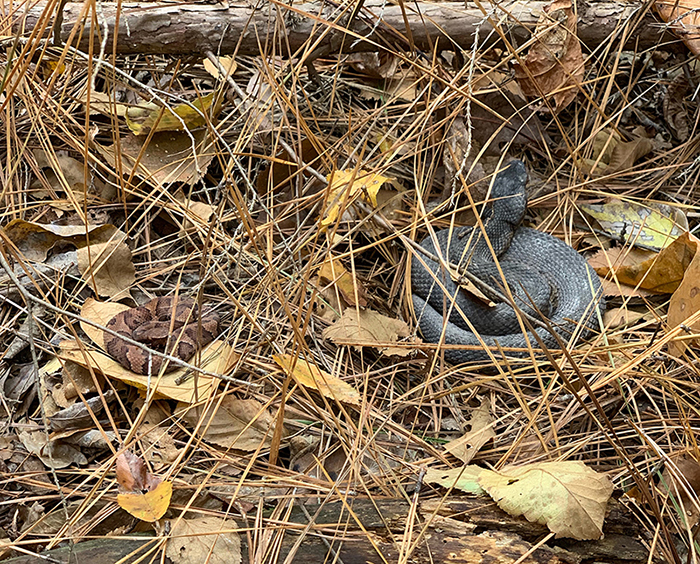
Forests are filled with wildlife throughout the year, even during winter months. Some varieties pose no danger but a few that do, like venomous reptiles, are still there. They may become less active during winter when reptiles often enter a state termed brumation: a condition of sluggishness, inactivity, or lethargy exhibited during winter that is not a true hibernation. But, in Southern regions, even this state can sometimes be omitted altogether.
Bird Forestry forester and wildlife biologist, Jered Rhodes, happened upon the two reptiles pictured above in the woods just a few days ago. He captioned his photo with, “Two Water Moccasins out and about before the weather stays too cold. Juvenile on the left and mature snake on the right.”
The water moccasin (Agkistrodon piscivorus) is a venomous snake predominant in the southeastern United States. Total adult length is commonly 26 to 35 inches while females are typically smaller than males.
Adults are capable of delivering a painful and potentially fatal bite. When threatened, they will often stand their ground and respond by coiling their bodies and opening their mouth at an intruder exposing the stark white lining (hence the common name “cottonmouth”) and displaying their fangs. Although some feel the moccasin’s aggression has been exaggerated, they may bite when feeling threatened or being handled.
Juvenile and subadult specimens usually have a more contrasting color pattern with dark crossbands on a lighter background, usually tan, brown, or reddish brown. The tip of the tail is often yellowish, greenish yellow or greenish in color on subadults, and then black to match overall body color found in most adults. However, the body banding pattern has also been found on the tail of some young reptiles. Young snakes have also been observed to wiggle the tips of their tails to lure prey.
Juvenile water moccasins are often confused with the copperhead which led to a lively office discussion at Bird Forestry about whether the pictured snake is, in fact, a moccasin or a copperhead. Opinions were divided, but Jered remains firm in his stance that it was a juvenile water moccasin. We’re not taking sides, but Jered is a wildlife biologist as well as a forester, and he was the one who got close enough to capture the picture.
Differences in the two do exist. A water moccasin has broad, dark stripes on the sides of its head that extend back from the eye, whereas the copperhead has only a thin, dark line that divides the pale border along the mouth opening and upper jaw from the somewhat darker color of the head.
Please note that we don’t recommend examining one closely enough to identify these subtle differences in markings should you encounter one in the woods. We do, however, strongly suggest exercising extreme caution and avoiding the reptile, regardless of its assumed species.
Some water snakes of the nonvenomous Nerodia species are similar in appearance to venomous pit viper moccasin but have round pupils, no loreal pit (the deep depression in the area on either side of the head found on pit vipers), and a distinctive overall color pattern.
Contrary to popular belief, moccasins are not limited to aquatic habitats. Large specimens have been found more than a mile from water. They have also been observed swimming across large bodies of water and are capable of biting under water.
Enjoy your time in the forests observing and appreciating nature but be aware of all forms of wildlife during all seasons. You are in their habitat, and they are often willing to defend it.
Contact Bird Forestry for assistance with the management of your forestland resources. We have been managing and marketing forest products for our clients for many years, and we understand the importance of your forestland assets. Let us help you reach your forest and land management goals.



